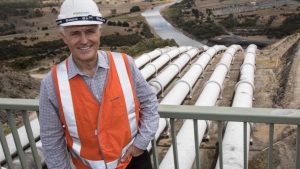In an exclusive interview shortly after the launch of the Clean Energy Finance Corporation, the review panel chair discusses the findings with RenewEconomy‘s Giles Parkinson.
Giles Parkinson: Congratulations on the report. What, for you, was the most confounding aspect of the report, or the most challenging part?
Jillian Broadbent: I don’t know about confounding as much as it was a journey of encouragement, finding working models that were in existence and successful around the world and uncovering the real need and the benefit for a corporation like this.
GP: Does the opposition to the Clean Energy Finance Corporation surprise you at all, considering this need?
JB: It does somewhat, but I think that relates to a lack of understanding about the way it’s intended to function.
GP: In what way do you mean?
JB: I think it’s been referred to as a slush fund, as though the money is just going to be handed out without the expectation that it’s going to be repaid, whereas the context is one of mobilising private sector skills and disciplines for a public policy outcome.
GP: But there seems to be an antipathy towards clean energy in some of these investments, anyway, isn’t there?
JB: It’s very hard to know whether people are anti the idea of government engagement with clean energy, but government has to be engaged in energy as a significant component to economic growth. It’s critical. Government has been involved in energy ever since it has been used in the economy.
GP: A lot of the debate in the US, where they have a similar scheme, has centred around some high profile failures. Will the CEFC be scared of failure? Will it be extra cautious because of what’s happened there and because of the political rhetoric around this fund?
JB: Perhaps so, but it’s important to recognise that the US structure was part of the government, as opposed to an independent corporation, so it didn’t have the arm’s-length independence and the strict financial disciplines that the CEFC intends to have.
GP: That presents an extra challenge, though, doesn’t it, in these new industries, when you’ve got costs of technologies that are falling quite rapidly as well? That throws an extra element of risk.
JB: That was particularly the case with Solyndra, where they were producing solar photovoltaic cells and the Chinese just undercut them by a factor of 10, so it went from being viable to nonviable. And also, they invested a significant amount in a corporation. It wasn’t a project.
GP: Can you confirm whether you’d be taking on a role with the CEFC once it’s up and established? You’ve been chair of this review. Will you be chair in the corporation?
JB: That’s my intention, and I understand the government will invite me to do so.
GP: And then it’s just a matter of appointing a board and chief executive and staffing it after that.
JB: Yes.
GP: Ok. You’ve asked for the funding to be inscribed in legislation. Presumably that’s to guarantee that the funds are actually there. That would be critically important, wouldn’t it?
JB: That’s correct.
GP: You mentioned, also, in the report that it assumes the continuation of the renewable energy target and also the carbon price. How will the CEFC operate in the future if the carbon price is repealed?
JB: I think the intention of the CEFC is to operate on the assumption of a continuation of existing government policies, and should the government change then you operate under the assumption of a continuation of new government policies. But the problem in the private sector is it is reluctant to anticipate what the change of the government policy would be or even assume that the existing government policy will continue because there’s been so much change in this area.
GP: Are you worried that the CEFC itself might be repealed, as is threatened by the Opposition?
JB: I’d be disappointed. Through our research and consultation and through reading the submissions, the review panel has had its views on the concept, the success and the role for the CEFC reinforced. I’d like to think that the Opposition is open to sharing those learnings with us.
GP: With the two streams of investment – renewables and hybrid and enabling technologies on one hand, and low emissions technologies on the other, you have asked for some flexibility in the targets.
JB: Yes, the reason for saying it’s a goal rather than a strict adherence is that, practically, it’s very hard to start moving at all if you’ve got to have an equal amount in each box.
GP: What sort of projects do you think are going to appeal to financiers, mostly, because financiers tend to like infrastructure and fixed rate of returns? Do you think some of those enabling technologies might be more appealing to them than some of the generation projects, as it were, and some of the manufacturing projects? Do you have any sense of how that will unfold?
JB: It depends if we’re talking about equity or debt. Financiers are a bit hesitant about equity and they require specialised funds, and I imagine that equity is going to be a little bit later in the stage for us. But it is a learning process and there is an opportunity for the CEFC to develop a knowledge base and share that knowledge, which hopefully then encourages investors to look at projects where a co investor already exists.
GP: You’re getting $10 billion of funds. That’s $2 billion a year coming in over five years. How much investment do you think you are going to be able to leverage with that?
JB: When we looked at this we thought probably one to five or more. We might find there’s a project where there’s a fair amount of capacity to leverage debt if we’re putting in a little bit of equity. If you’re talking about just matching debt, it would be a much lower figure.
GP: So, you’re talking about leveraging more than $50 billion of private investment?
JB: I suspect it’s probably likely to be more like five times leverage if we start off with debt rather than equity.
GP: And just to make it clear, is there any timeframe for the actual deployment of this capital? I know that capital comes in yearly deposits over five years, but the actual deployment, I presume, is over a longer timeframe. You’re not going to be trying to spend $2 billion a year? Or how do you see that happening?
JB: The rate of investment is not mandated. It’s really going to depend on the transactions and the filtering process and what’s selected and what’s appropriate to invest in.
GP: I can imagine you’re going to be overwhelmed at the start by dozens and dozens and dozens of projects.
JB: We are overwhelmed by dozens and dozens of projects, but that reinforces the need for the CEFC.
GP: You talked about loan guarantees. You don’t see them as being particularly efficient. Could you expand upon that?
JB: The expectation is that the CEFC will effectively put at risk $10 billion. Whether you put it at risk by giving a loan guarantee or actually lending out the money, it’s the same amount being put at risk. And if you provide a loan guarantee, it’s going to be likely to be less effective because someone else has to raise the funds and get some margin on it rather than you actually directly invest in the government fund. So, you have it on someone else’s balance sheet, so they require a credit spread for putting it on their balance sheet against your guarantee.
GP: So the fact that you’ll be providing loans in some cases and maybe equity down the track, you’re confident then that this barrier that you defined – which is the institutions their lack of understanding about the technology, the tenor and the cost – these can all be either improved or reduced?
JB: I believe so. In the case of tenor, it will be extended rather than reduced; and in the case of cost, the expected rate of return being the government’s cost of funds compared with the banking cost of funds plus a margin is certainly a reduction.
GP: I guess the whole basis, then, of this proposition is that that will actually make the difference between those technologies getting finance and making commercial sense or not.
JB: Well, tenor is a very significant factor in finance at the moment. There just isn’t long-term finance available, so even having available long-term finance at a reasonable rate, the projects tend to be capital-intensive and the value of that is quite significant.
GP: David Paradice and Ian Moore worked with you. Will they be putting their hands up, also, to join the CEFC in some capacity?
JB: We haven’t determined how that will be structured. David Paradice has found it a little bit difficult to give us the time that we want, but Ian Moore is certainly committed to stay on the board.
GP: And what have you learned most over this process? What is the thing that struck you most after this five months about the industry or the possibilities going forward?
JB: I think there is a sense of excitement about the possibilities for the sector for Australia and the energy and capacity out there to pursue it.
GP: You think, then, with this mechanism – with the right mechanism – that Australia will actually be able to finally deploy that capital and therefore deploy those technologies or those projects that enable it to catch up with the rest of the world?
JB: I think it’s an important component in a suite of important initiatives by the government. Whenever you’ve got a capital-intensive industry and it is new and you’ve got inefficiencies in mobilising the capital towards it, it doesn’t always flow as smoothly as you might like. If the CEFC can play a role in facilitating that flow of funds, I think Australia would be better positioned for a carbon-constrained world.







